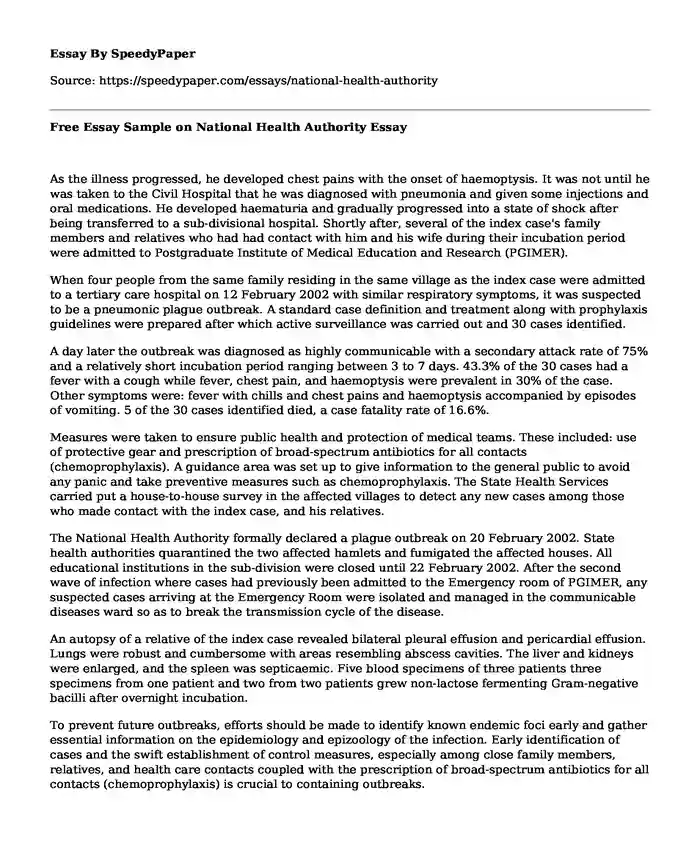
| Type of paper: | Essay |
| Categories: | Health and Social Care Medicine |
| Pages: | 3 |
| Wordcount: | 643 words |
As the illness progressed, he developed chest pains with the onset of haemoptysis. It was not until he was taken to the Civil Hospital that he was diagnosed with pneumonia and given some injections and oral medications. He developed haematuria and gradually progressed into a state of shock after being transferred to a sub-divisional hospital. Shortly after, several of the index case's family members and relatives who had had contact with him and his wife during their incubation period were admitted to Postgraduate Institute of Medical Education and Research (PGIMER).
When four people from the same family residing in the same village as the index case were admitted to a tertiary care hospital on 12 February 2002 with similar respiratory symptoms, it was suspected to be a pneumonic plague outbreak. A standard case definition and treatment along with prophylaxis guidelines were prepared after which active surveillance was carried out and 30 cases identified.
A day later the outbreak was diagnosed as highly communicable with a secondary attack rate of 75% and a relatively short incubation period ranging between 3 to 7 days. 43.3% of the 30 cases had a fever with a cough while fever, chest pain, and haemoptysis were prevalent in 30% of the case. Other symptoms were: fever with chills and chest pains and haemoptysis accompanied by episodes of vomiting. 5 of the 30 cases identified died, a case fatality rate of 16.6%.
Measures were taken to ensure public health and protection of medical teams. These included: use of protective gear and prescription of broad-spectrum antibiotics for all contacts (chemoprophylaxis). A guidance area was set up to give information to the general public to avoid any panic and take preventive measures such as chemoprophylaxis. The State Health Services carried put a house-to-house survey in the affected villages to detect any new cases among those who made contact with the index case, and his relatives.
The National Health Authority formally declared a plague outbreak on 20 February 2002. State health authorities quarantined the two affected hamlets and fumigated the affected houses. All educational institutions in the sub-division were closed until 22 February 2002. After the second wave of infection where cases had previously been admitted to the Emergency room of PGIMER, any suspected cases arriving at the Emergency Room were isolated and managed in the communicable diseases ward so as to break the transmission cycle of the disease.
An autopsy of a relative of the index case revealed bilateral pleural effusion and pericardial effusion. Lungs were robust and cumbersome with areas resembling abscess cavities. The liver and kidneys were enlarged, and the spleen was septicaemic. Five blood specimens of three patients three specimens from one patient and two from two patients grew non-lactose fermenting Gram-negative bacilli after overnight incubation.
To prevent future outbreaks, efforts should be made to identify known endemic foci early and gather essential information on the epidemiology and epizoology of the infection. Early identification of cases and the swift establishment of control measures, especially among close family members, relatives, and health care contacts coupled with the prescription of broad-spectrum antibiotics for all contacts (chemoprophylaxis) is crucial to containing outbreaks.
References
The source (Joshi et al., 2009) referenced the following seven sources:
Clem A, Galwankar S. (2005). Plague: a decade since the 1994 outbreaks in India. J Association Physicians India, 53:457-64.
Gani R., Leach S. (2004). Epidemiologic determinants of modelling pneumonic plague outbreaks. Emerg Infect Dis, 10:608-14.
John T. J. (1996). Emerging and re-emerging bacterial pathogens in India. Indian J Med Res, 103:4-18
Mittal V., Rana U.V., Jain S.K, Kumar K., Pal I.S., Arya R.C., Ichhpujani R.L., Lal S. (2004).Quick control of bubonic plague outbreaks in Uttal Kashi. India J Commun Dis, 36:3339.Seal S.C. (1949). Epidemiology of plague concerning the present Calcutta outbreak. Calcutta Med J, 46:167.
Sehgal S., Bhatia R. (1991). Plague in India. Delhi: National Institute of Communicable Diseases.
WHO (1999). Plague manual: epidemiology, distribution, surveillance and control. Geneva: World Health Organization, WHO/CSR/EDC/99.2.
Cite this page
Free Essay Sample on National Health Authority. (2019, Sep 16). Retrieved from https://speedypaper.com/essays/national-health-authority
Request Removal
If you are the original author of this essay and no longer wish to have it published on the SpeedyPaper website, please click below to request its removal:
- Advantages of the Internet Technology Essay Sample
- Communication between doctor and patient
- Essay Sample: Examining a Tradition Term from Different Perspectives
- Paper Example. Criminalistics SUB
- Essay Sample on Prevalence of Food-Borne Infections
- Essay Sample on the Marketing Challenges Facing Clocky
- Essay Sample on Autism and Asperger's Syndrome
Popular categories




